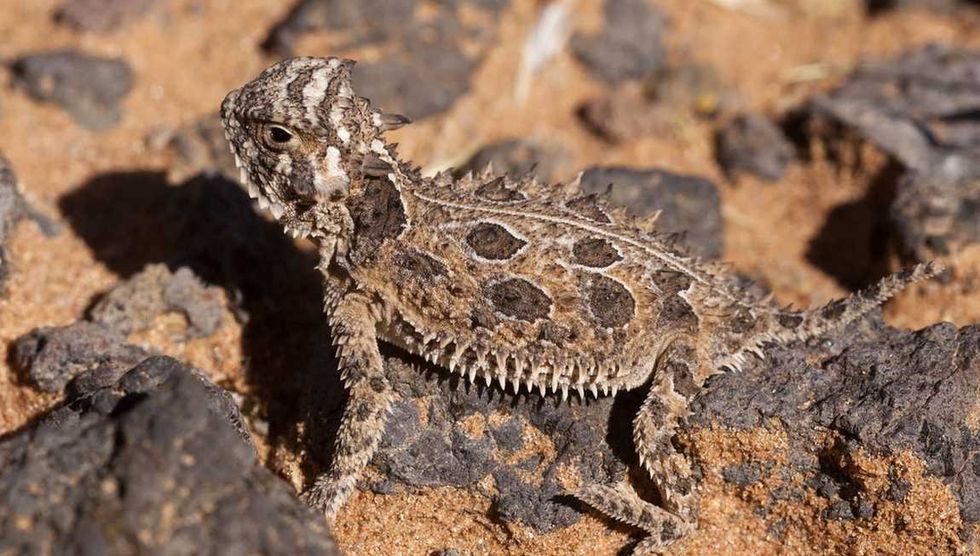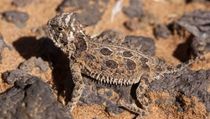Given a synonym as a horny toad, the Texas horned lizards (Phrynosoma cornutum) are spiny-bodied lizards of the Phrynosomatidae family. It is the combination of horns gracing the back of the lizard's head along with a series of pointed scales dividing the short, squat bodies that differentiate these horned lizards from the other lizards of Oklahoma.
Besides their fascinating appearance, Texas horned lizards possess a peculiar defense mechanism. The members of the species are known to engage in a motionless stance and remain so until the danger passes.
Another interesting aspect of the Texas horned lizard's defense is the famous Texas horned lizard shooting defense. This is the last defense mechanism employed when this species is threatened by Texas horned lizard predators.
When confronted by a predator, this creature shoots blood from its eye sockets.
The sight of the Texas horned lizard shooting blood is quite intimidating for the predators, who run away after being exposed to the Texas horned lizard's bloody eyes. This same mechanism is also used by the Texas horned lizard to keep its eyes clean.
The species draws its name from the two large horns that are present at the back of the head. The Texas horned lizard is also known by its scientific name Phrynosoma cornutum.
Read on for some interesting facts about these horned members of the lizard family. After reading these Texas horned lizard facts, do check out our other articles on the caiman and the crested gecko.
Texas Horned Lizard Interesting Facts
What type of animal is a Texas horned lizard?
Texas horned lizard (scientific name Phrynosoma cornutum) is a group of lizards, categorized among the 14 North American species of horned lizards. These lizards are often designated as horned toads or horned a frog.
What class of animal does a Texas horned lizard belong to?
Texas horned lizard (Phrynosoma cornutum) belongs to the class Reptilia; that is, a class of organisms that are categorized for their creeping and crawling mode of locomotion and for the dry cornified skin, epidermal scutes, and scutes that cover the body of these organisms.
How many Texas horned lizards are there in the world?
There are no exact and correct details available about the total populations of Texas horned lizards, however, according to the available records, these spikey-bodied lizards are amongst the most widely distributed species, covering broad geographical regions of the US, especially dunes.
Where does a Texas horned lizard live?
Dwellers of semi-arid or arid regions, Texas horned lizards, prefer to inhabit near open grounds with the availability of scattered vegetation. Deserts, prairies, desert basins, dunes, or the slopes of fertile soil are the preferred habitats of the Texas horned lizard. During their hibernation periods, Texas horned lizards lodge under foliage or soil.
What is a Texas horned lizard's habitat?
Texas horned lizards live in habitats that are widely distributed over the topography of Mexico and the United States.
As per Texas Parks and Wildlife Department, the geographic range of horned lizard's habitat spans across terrains of Arkansas, Colorado, southwest Missouri, Kansas, Louisiana, and Arizona, these spiky lizards can be easily located throughout the geographical distribution of Oklahoma and Texas.
Phrynosoma cornutum has also been introduced in several habitats besides their native homes. These lizards find new habitations in Florida, Wyoming, Colombia, and Michigan.
Who do Texas horned lizards live with?
Texas horned lizards are solitary reptiles. These spiny-bodied lizards are observed to prefer company only during mating seasons. Besides, they may also interact with the other members of their species while competing for establishing feeding territory around ant populations.
How long does a Texas horned lizard live?
The average lifespan of Texas horned lizards is known to be about five years. However, the maximum longevity in these species of lizards was observed to range between seven and eight years in captivity. They prefer living near ant populations from where they can feast on their favorite harvester ants.
How do they reproduce?
The reproductive cycle in Texas horned lizards starts following the hibernation period of the reptiles. Usually, the mating season falls from April to mid-June.
Coming out of their solitary living habits, the male Texas horned lizards travel in search of potential females for reproduction. On approaching a receptive partner, they communicate by bobbing their heads. During mating, the male members mount the female for insemination procedures.
Following mating, the partners reject further interactions. The female Texas horned lizards are known to lay their eggs in a burrow following fertilization. A gestation period of 44 days and incubation of about 40-61 days is observed in Phrynosoma cornutum.
Generally, the females exhibit a single clutch during each breeding season. The clutch size usually ranges between 14-37 eggs.
What is their conservation status?
According to the IUCN’s Red List, the Texas horned lizard species has been categorized under the conservation status of Least Concern.
This means that the population of these horny lizards belonging to the family of Phrynosomatidae can be safely predicted to be steady and rapidly growing, hence removing any doubts over the Texas horned lizard conservation.
The Texas horned lizard's endangered status is not a cause of concern at present, thus removing any immediate concerns regarding Texas horned lizard protection and conservation. Oklahoma Department of Wildlife Conservation received a petition from the Center for Biological Diversity in Tucson in 1994.
This petition was concerned with putting Texas horned lizard on the Endangered Species List as its populations declined rapidly in the region.
Texas Horned Lizard Fun Facts
What do Texas horned lizards look like?

Texas horned lizards are among the North American species of spiny-bodied lizards and are named for their horned appearance. The body of this reptile is round and short, covered with cornified scales.
These wild lizards possess the ability to flatten their body to hide from a predator. Two large horns adorn the back of the Phrynosoma cornutum head followed by smaller ones lining the temporal portions of the crown.
The dorsal part of the body in Texas horned lizards is separated from the scaly ventral part by a series of double rows of spiky scales.
The horns of Texas horned lizards are true bones, formed by the protrusion of the cranium. The shading in the members of Phrynosoma cornutum species depends on their distributional range, to provide camouflage.
They range in color from red, yellow, brown, and gray to reddish-brown or tan, patterned with dark blotches, irregular markings, and lines. Texas horned lizards possess anatomically short pointed tails.
How cute are they?
Texas horned lizards with their spiny appearance and dark shading may look more fierce and formidable than cute. However untrue to its fierce appearance, these are a group of docile reptiles.
How do they communicate?
Texas horned lizards utilize their body movements to communicate and perceive the world around them. These lizards are known to bob their heads and stretch their heads or part of their body to communicate with the other members of their species or perceive their surroundings.
How big is a Texas horned lizard?
The Texas horned lizard's size ranges between 2.7-4.5 in (6.8-11.4 cm). The females of the species are larger than their male counterparts and grow up to a total length of about 4.5 in, while the male reaches a maximum length of 3.7 in (9.4 cm).
How fast can a Texas horned lizard run?
There are no exact details about the running speed of Texas horned lizards; however, these lizards are known to gain quite a pace, running in short bursts under dire circumstances such as when threatened by predators.
How much does a Texas horned lizard weigh?
The Texas horned lizard's range of weight is 0.9-3.2 oz (25.5-90.7 g). The Texas horned lizard's weight varies as per the size of the animal.
What are the male and female names of the species?
There is no specific designation allotted to the members of the Texas horned lizard species based on their sex. The male members of the species are referred to as male Texas horned lizards while the females are referred to as female Texas horned lizards.
What would you call a baby Texas horned lizard?
A Texas horned lizard baby is referred to as a hatchling, neonate, or juvenile.
What do they eat?
Texas horned lizards are carnivorous organisms; that is, these animals feed on other wildlife for survival. The diet of Phrynosoma cornutum includes harvester ants, beetles, grasshoppers, and termites.
Are they dangerous?
Though the Texas horned lizard's appearance is quite fierce and formidable, owing to its spiny-bodied appearance, but these reptiles are quite docile. These horny lizards prefer isolation and do not attack unless genuinely provoked. When threatened, these horned toads are known to bite humans as well.
Would they make a good pet?
No, these horned lizards can’t make good pets because these horned toads require an open habitat to dwell in. Moreover, only experienced animal keepers can keep them under good conditions and care. So, seek an expert opinion before you get a Texas horned lizard as a pet.
Did you know...
Phrynosoma cornutum, which is the binomial nomenclature of the Texas horned lizard, is assigned due to the toad-like appearance of the reptile. In literal meaning, Phrynosoma stands for toad-bodied and cornutum designates the horns.
The horns, that is the defining characteristics of Phrynosoma cornutum, are made up of true bones, as it is essentially an extension of the cranium of the reptile.
Phrynosoma cornutum is the mascot of Texas Christian University. The lizard can be seen on the University's seal.
Texas horned lizards are a group of reptiles that love their Vitamin D. These lizards are big fans of sunbathing.
The Phrynosoma cornutum is known to emit the famous Texas horned lizard blood squirt, up to a distance of about 5 ft from its mouth and the corner of its eyes to confuse its predators. The ability is used as a defense mechanism.
What are some other names for the Texas horned lizard?
The Texas horned lizard, biologically classified as Phrynosoma cornutum, is often nicknamed the horned toad, or horned frog, despite being a group of horn-adorned reptiles. The Phrynosoma cornutum is labeled as a toad or frog for its rounded body, embedded with blunt snouts, giving the lizards an appearance similar to that of a toad or frog.
What is the symbolic status of the Texas horned lizard?
The Texas horned lizard was a sign of happiness and health by ancient Native Americans. These spiny-bodied reptiles were given sacred stations and were portrayed in petroglyphs, pottery, and other forms of art.
Here at Kidadl, we have carefully created lots of interesting family-friendly animal facts for everyone to discover! Learn more about some other reptiles including the mangrove snake and the yellow anaconda.
You can even occupy yourself at home by drawing one of our Texas horned lizard coloring pages.









